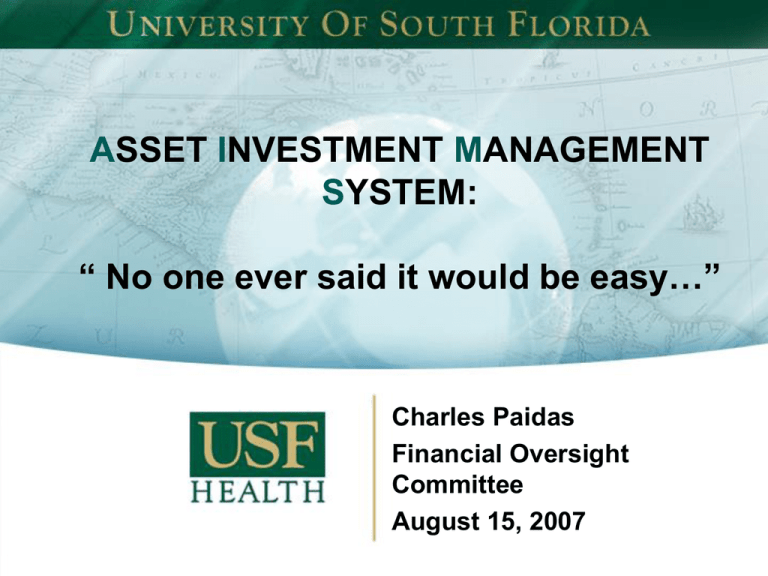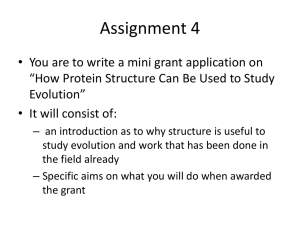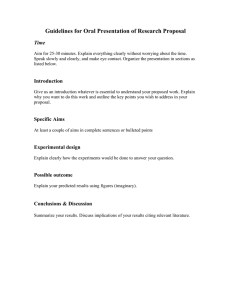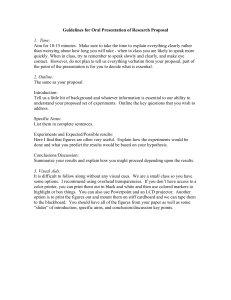AIMS: No one ever said it would be easy...
advertisement

ASSET INVESTMENT MANAGEMENT
SYSTEM:
“ No one ever said it would be easy…”
Charles Paidas
Financial Oversight
Committee
August 15, 2007
The AIMS Council
Co-Chairs
Bruce Lindsey
Basic Sciences
Chuck Paidas
Clinical Sciences
Joann Strobbe
Finance & Administration
Members
Michael Barber, Past Pres Faculty Council
Robert Belsole, Clinical Affairs
Eric Bennett, Molecular Pharmacology & Physiology
H. James Brownlee, Family Medicine
Karen Burdash, Clinical Finance
Duane Eichler, Molecular Medicine
Peter Fabri, GME
Frank Fernandez, Psychiatry
Harvey Greenberg, DIO
Joseph Jackson, USFPG
Jim McKenzie, USF Health IT
Vicky Mastorides, Dean’s Office
Jean Nixon, Business Office
Robert Nelson, Pediatrics
John Curran, Fac/Acad. Affairs
William Quillen, Physical Therapy
Abdul Rao, Research
Paul Wallach, Education
Lynn Wecker, Research
Paula Knaus, Dean’s Office
AIMS: OBJECTIVES
To support College of Medicine Mission, Goals,
and Strategic Plan by:
1) Aligning resources with missions:
The All Source Funding Model
2) Implementing a salary program that
links assignment and performance to
pay.
Kickoff = March 9, 2005
Meaningful Links
Assignment
Performance
Performance
Pay
The AIMS Council
Phase 1
COM Basic Science and Clinical Ranked
Faculty
• Implement an All Source Funding Model
• Pilot College wide Performance
Expectations
• Create The Data Warehouse/dashboard
• Revise the Annual Assignment and
Evaluation Forms
The AIMS Council
Summary of Accomplishments - 1
• Established COM minimum percentages of
effort per assignment category for ranked
faculty with substantial input from Vice Deans
(5-5-3-2)
• Identified measurable College performance
expectations for ranked faculty
• Created a plan to develop additional
measurable Department-specific performance
expectations for Clinical faculty
The AIMS Council
Summary of Accomplishments - 2
• Created Data warehouse and Dashboard
-Health Analysis Reporting Tracking (HART)
• Implemented Pilot Program of Draft
of College wide and Departmental
performance criteria
• Established web site for transparency
- http://www.hsc.usf.edu/medicine/aims/index.html
The AIMS Council
Future Phases
Performance expectations and evaluation
of:
• Chairs
• Staff
• Administration
KEY CONCEPTS
• Faculty driven process
• Let’s learn from the pilot data
• 360° Transparency of data
• First we need to understand what we do. What
is our definition of work?
- Practice plan
- Basic Science
• We have yet to arrive at an evaluation
component.
KEY CONCEPTS
• Productivity not allocation
• Strategic cost assessment
- What is the cost of doing business must
be preceded by knowing the business.
•How we stack up
- internally
- nationwide
Pilot Departments:
• Psychiatry
• Pediatrics
• Family Medicine
• Basic Sciences
• Physical Therapy
• OBGYN
2006-2007
College of Medicine Minimum Percentages of Effort for
Ranked Faculty (Revised by Council 3/30/06)
CATEGORY
COLLEGE - WIDE
Instruction
5%
Scholarly Activity
5%
Service/Governance
3%
Clinical Care
Other (Professional Development or
Leave of Absence with Pay)
*
2%
NOTE: The minimum required workweek for 1.00 FTE Faculty is 40 hours; faculty are expected to work the number of
hours necessary to accomplish their assigned responsibilities. The minimum work year is 46 weeks or 1840 hours.
*Not applicable to Basic Science faculty. Clinical Faculty assignment will include patient care
with and without students or house staff and will be benchmarked.
Pilot: Total Compensation For Ranked Faculty
AIMS and
College Criteria
AIMS
Criteria
$ 350K
Base
Promotion – Assistant
Associate
Full Professor
Cost of living adjustment
New Administrative Permanent Assignment.
If Grant is eliminated, non- tenure salary
eliminated.
ASF can decrease if clinical earnings are not
sufficient or department is in deficit.
Does not meet 5/5/3/2 (after PILOT)
Incentive /
Bonus
Total
Compensation
Eligibility
Meets 5/5/3/2 minimum
expectations
Plus
- Research / Scholarly Activity Criteria
- Education Criteria
- Clinical Criteria
Not eligible if 5/5/3/2 not met
Systems and Quality
Management Committee (SQMC)
SQMC Service and Clinical Metrics
Metric
1. Patient satisfaction
2. Patient complaints
3. Patient complaints
regarding providers
4. Discharges of
patients from USFGP
5. Physician
cancellations of
patients’
appointments
6. Appointment
availability
7. USFPG Consultations
8. Patient waiting time
at visit
9. Clinical measures
Definition
Standards Department Division
Individual
USFPG
Clinical Quality Indicators
• TGH Quality Indicators
– Discharge times
– Operative reports
Performance Criteria for Basic
Scientist and Clinical Faculty
(Handouts)
•
•
•
•
Instruction
Scholarly Activity
Service/Governance
Professional Development
AIMS Metrics (Pulmonary Division
Level)
Metric
Definition
Base
Incentive
Bonus
Work RVU’s
No. of Providers x pro
rata assignment
75th perc.
80th perc.
85th perc.
Collected
Revenue
Annualized $’s
$2.5M
$2.7M
$3.0M
New Program
Interventional
Pulmonary initiated (at
year end)
-
-
Yes
Fellow Education
Core Curriculum
Lectures
-
-
?
Fellow Education
Fellow presentations
10
15
20
Medical Student
Education
Simulator training for
Year 1 Students
-
-
Yes
Medical Student
Education
4th Year Critical Care
Clerkship
35 hours
60 hours
150 hours
AIMS Metrics (Pulmonary Division
Level)
Metric
Definition
Base
Incentive
Bonus
Clinical Trials –
Pulmonary
Hypertension
Number
1
2
3
Abstracts
Number
-
-
4
Fellow Research
Each Year 2 or 3 Fellow
on Research Project
-
-
Yes
Clinical Trial
Revenue
Annual Dollars
-
-
$50K
AIMS Salary Subcommitee:
The realistic solution
• EXPENSES
for all Clinical departments:
range = 50 – 67%
Dean’s Tax
7%
Corporation 20.9%
Department
10-14%
Division
~ 30%
Education
Mission
Research
Clinical
The Tipping Point
Rao
Bognar
AIMS
Council
Belsole
AIMS: FAQ’s from Faculty
• Everyone can be treated fairly but no one
can be treated the same!
• All assignments are Pro rated based upon
FTE.
– {0.8 vs 1.0 vs. 0.2 FTE} x {wRVU, Education} =
% performance effort
• If people are happy then leave them alone.
• Academic medicine means something, what
exactly does it mean?
AIMS: FAQ’s clinical issues
• Must understand sources of money.
Hard money = TGH, Moffitt,
Feds, State Contracts and State $
Soft Money = patient revenue
• In order to increase revenue we must either:
increase the contracts or decrease the
expenses associated with soft money
Team Observations during the interviews:
“…Hey no one said it would be easy”
• AIMS is an essential element of modern day
academic health care fiduciary responsibility
and academic solvency.
• Life is complex in an academic world when
we begin talking about sources and uses of
capital (The All Source Funding Model) and
pay for performance.
• Paucity of working knowledge about COM
throughout faculty
• Disparity of feelings. Psychosis/Fear people
will loose jobs. Others ecstatic !
Team Observations
Key Survey Concepts
• Faculty driven process
•
Let’s learn from the pilot data
• First we need to understand what we do. What is
our definition of work?
- Practice plan
- Basic Science
•
•
•
•
We have yet to arrive at an evaluation component.
Productivity not allocation
Strategic cost assessment
The cost of doing business must be preceded by
knowing the business.
– How we stack up internally and nationwide
– 360° Transparency of data
AIMS Summary
SWOT Analysis
Strengths: Faculty and Chair Buy-In. Levels the
playing field. Reward the Knowledge Worker.
Enhance dialogue. Improves APT. LCME
Weaknesses: Talk is cheap. Don’t stop here. Will it
control expenses? Self Reporting. Cross
Subsidization. Unrealistic requirements. LCME
Opportunities: “Eat what you kill,” Align Sources
and Uses of Capital. Expense Control. LCME.
Threats: Disintegration of academic spirit. Legal
Woes. Enforce of non-Compliance. LCME
Personal Observations
• Behavior has changed already
• Faculty beginning to become aware of
advantages to pay for performance
• Misconceptions abound
• The title is a privilege not a right
• Repetition is key
• The pilot will help align effort, performance
and pay
• If we don’t get our house in order someone
else can easily do it.
Pilot Highlights
updated August 2007
• Clinical Activity “How you will be paid”
– Incentive and Bonus will be wRVU based not
dependent upon Education.
– Appendix III and IIIa (examples)
• Instruction
– Key phrase is educational programs = 40 hrs
– Appendix I
Basic Science Bonus Model August, 2007
• Basic Science Faculty are eligible for a Bonus in the following
circumstances:
• In addition to meeting the College-wide Base Pay performance
requirements, must:
• meet the Bonus Pay performance requirements for Medical
Student Instruction (Appendix I ); and,
• meet the Bonus Pay performance requirements for Graduate
and Postdoc Instruction (Appendix II); and,
• meet the Bonus Pay performance requirements for
Research/Scholarly Activity (Appendix IVb).
• If a faculty member does not meet all of the performance
requirements for teaching, research and service, and performs
at an outstanding level for two out of three of the performance
requirements, an exception may be made to the above Bonus
requirements with approval by the Chair and Vice Dean for
Research.
Faculty Merit Process
Criteria for 2006-2007
• Basic Science Ranked Faculty
• Clinician Ranked Faculty



